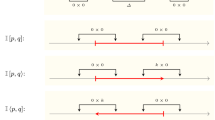Abstract
Persistent homology has proven to be a useful tool in a variety of contexts, including the recognition and measurement of shape characteristics of surfaces in ℝ3. Persistence pairs homology classes that are born and die in a filtration of a topological space, but does not pair its actual homology classes. For the sublevelset filtration of a surface in ℝ3, persistence has been extended to a pairing of essential classes using Reeb graphs. In this paper, we give an algebraic formulation that extends persistence to essential homology for any filtered space, present an algorithm to calculate it, and describe how it aids our ability to recognize shape features for codimension 1 submanifolds of Euclidean space. The extension derives from Poincaré duality but generalizes to nonmanifold spaces. We prove stability for general triangulated spaces and duality as well as symmetry for triangulated manifolds.
Similar content being viewed by others
References
P.K. Agarwal, H. Edelsbrunner, J. Harer, Y. Wang, Extreme elevation on a 2-manifold, Discrete Comput. Geom. 36, 553–572 (2006).
D. Cohen-Steiner, H. Edelsbrunner, D. Morozov, Vines and vineyards by updating persistence in linear time, in Proc. 22nd Ann. Sympos. Comput. Geom., 2006, pp. 119–126.
D. Cohen-Steiner, H. Edelsbrunner, J. Harer, Stability of persistence diagrams, Discrete Comput. Geom. 37, 103–120 (2007).
M.L. Connolly, Shape complementarity at the hemo-globin albl subunit interface, Biopolymers 25, 1229–1247 (1986).
H. Edelsbrunner, D. Letscher, A. Zomorodian, Topological persistence and simplification, Discrete Comput. Geom. 28, 511–533 (2002).
R. Gonzáles-Díaz, P. Real, On the cohomology of 3D digital images, Discrete Appl. Math. 147, 245–263 (2005).
N. Gelfand, N.J. Mitra, L.J. Guibas, H. Pottmann, Robust global registration, in Proc. Sympos. Geom. Process., 2005, pp. 197–206.
M. Hilaga, Y. Shinagawa, T. Komura, T.L. Kunii, Topology matching for fully automatic similarity estimation of 3D shapes, in Computer Graphics Proc., Siggraph 2001, pp. 203–212.
J.R. Munkres, Elements of Algebraic Topology (Addison-Wesley, Redwood City, 1984).
G. Reeb, Sur les points singuliers d’une forme de Pfaff complèment intégrable ou d’une fonction numérique, C. R. Acad. Sci. 222, 847–849 (1946).
Y. Wang, P.K. Agarwal, P. Brown, H. Edelsbrunner, J. Rudolph, Coarse and reliable geometric alignment for protein docking, in Proc. Pacific Sympos. Biocomput., 2005, pp. 65–75.
A. Zomorodian, G. Carlsson, Computing persistent homology, Discrete Comput. Geom. 33, 249–274 (2005).
Author information
Authors and Affiliations
Corresponding author
Additional information
Communicated by Konstantin Mischaikow.
Research by all three authors is partially supported by DARPA under grant HR0011-05-1-0007. Research by the second author is also partially supported by NSF under grant CCR-00-86013.
An erratum to this article can be found at http://dx.doi.org/10.1007/s10208-008-9038-9
Rights and permissions
About this article
Cite this article
Cohen-Steiner, D., Edelsbrunner, H. & Harer, J. Extending Persistence Using Poincaré and Lefschetz Duality. Found Comput Math 9, 79–103 (2009). https://doi.org/10.1007/s10208-008-9027-z
Received:
Revised:
Accepted:
Published:
Issue Date:
DOI: https://doi.org/10.1007/s10208-008-9027-z



